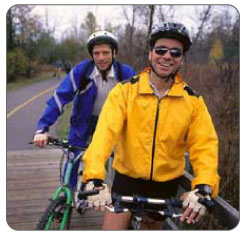|

More Facts About Knees:
Babies are born without knee caps. They appear when the child reaches 2-6 years of age.
The knee is the largest articular joint in the body.
Each knee has two tough, rubbery menisci that act as shock absorbers in the joint.
One meniscus sits on the inside of the knee joint and is referred to as the medial meniscus. The other meniscus rests on the outer part and is referred to as the lateral meniscus.
Arthritis is one of the most common causes of knee bursitis.
Many of our customers have had excellent results with Knee TShellz Wrap® for bursitis in the knee.
Runner's knee is not exactly a condition in itself. It sums up a multitude of knee disorders with different causes all centering around the kneecap.
Obesity and improper body alignment are responsible for many knee injuries.
Optimal knee treatment includes avoiding activity, icing the inflammation, gently stretching and warming the area.
Increased blood flow can speed ACL, PCL and meniscus recovery significantly.

| Cyclists' Knee Pain
Cycling is a low impact activity and is considered a good exercise option for people with knee injuries or conditions. However, the repetitive motion of pedaling can lead to chronic overuse injuries in the knees. In fact, 40%-60% of cyclists, experience knee pain. Knee pain from cycling can be caused by the improper fit of the bike, anatomical factors, or training issues that put excess strain on the knees or leg muscles.
The 2 most common causes of knee pain caused by riding a bike is patella chondromalacia and Iliotibial Band Syndrome (ITBS). Patella chondromalacia causes pain beneath and around the kneecap. With ITBS you will experience pain in the lateral (outside) knee and possibly even the hip. Repetitive knee motions that occur when cycling may also lead to painful knee conditions such as patellar tendinitis (pain occurs overtop of and below the kneecap) and pes anserine bursitis (pain occurs below and on the inside of the knee).
Patellar Chondromalacia
Patellar chondromalacia, also known as runner's knee or patellofemoral syndrome, occurs when the smooth cartilage enabling the femur and kneecap to glide smoothly over one another becomes irritated or damaged and begins to deteriorate. The cartilage may soften, crack or blister resulting in pain and inflammation.
This damage is caused by regular wear and tear or by repetitive trauma due to unbalanced leg muscles or tightening of muscles from training and the patella (kneecap) becoming misaligned.
Patellar Chondromalacia patients complain of pain or discomfort under or around the sides of the kneecap. The pain often increases when using stairs, running up hill, jumping, getting out of a chair or when participating in other activities that put weight on the knee. A grinding feeling and/or sound may also occur when trying to straighten the knee. Swelling may also occur along with the pain and inflammation in the knee joint. These symptoms are caused by the degeneration of cartilage and the resulting irritation. Fortunately, doctors believe the damage can be repaired.
Iliotibial Band Syndrome
Iliotibial band syndrome occurs when the IT band becomes irritated, inflamed and tight. Excessive rubbing of the IT band over the tibial tubercle (bony prominence at the outside of the knee) is a common cause of the irritation that leads to inflammation of the tendon, tightness along the outer leg, and knee pain. In addition to knee pain, soreness in the hip may also occur.
Once inflammation in the IT band is reduced and healing begins, scar tissue begins to develop on the iliotibial tract. This scar tissue is tough and inflexible and it stops the muscles attached to the IT band from moving smoothly. This causes further pain at the knee and the tightness is usually felt in the hip (at the top of the iliotibial tract) and down the leg to the knee.
ITBS symptoms include pain on the outside of the knee that develops while cycling and subsides shortly after finishing. This pain eventually becomes more constant and is noticeable when doing other activities such as running, walking, and climbing up or going down stairs. As the iliotibial band becomes tighter, stiffness in the hip and outer thigh will occur. Following activity, pain and swelling around the knee usually becomes worse.
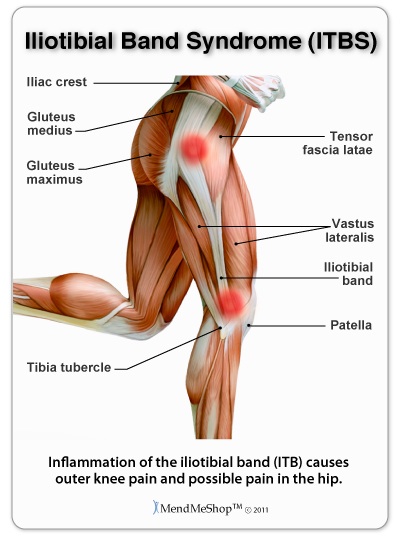
Whether your knee pain is caused by patellar chondromalacia or ITBS, if these symptoms become chronic, weakened quadriceps muscles may allow the leg to give out which can cause further injury to the knee or leg.
Causes of Cycling Knee Pain
- Overdoing it (increased intensity or distance) at any ability level
- Poor form when biking (i.e. incorrect cleat position, saddle height or positioning from bars)
- Misalignment of the kneecap (due to unbalanced leg muscle strength, flat feet, knock-knees, or overpronation) can cause the kneecap to slide over the femur abnormally
- Women are at greater risk because anatomically they experience greater lateral force on the knee
- Repetitive knee rotations while pedaling
Cycling Knee Pain Treatment - What Can Be Done?
When inflammation and tenderness occur at the front or lateral side of the knee, an initial program of rest, elevation and cold compression is recommended to reduce the pain and inflammation. Once inflammation has been reduced, a TShellz® Circulatory Boost Wrap can speed healing and nourish muscle tissue to prepare it for strenghtening and exercise.
To prevent further damage to the cartilage avoid exercises and activities, like cycling, that irritate the patella until the problem is corrected. If the cause of your pain is misalignment of the kneecap, selective exercises that strengthen the inner quadriceps muscles are recommended to straighten the movement of the patella over the femur. If improper bike fit has caused excess stress on the kneecap and femur, take corrective action and get your bike adjusted by a professional so it fits your body properly. Finally, if training issues are the cause, start cycling less intensely or for shorter distances and work up slowly to your desired level.
A typical conservative treatment outline for knee pain from cycling would be as follows:
- Rest - This is important for initial recovery; rest and elevation will help reduce pain, swelling and inflammation in the early stages of injury. This can be difficult when you have to carry on with daily activities, but resting and elevating your knee whenever you can is recommended. During your recovery you will probably have to modify or avoid the activities that put stress on your knee until your pain and inflammation settles. However, too much rest can also be harmful, as knee and ankle immobility can actually cause stiffening in the joints. This is why rest should be used when reducing initial pain and swelling, but should not be considered for more long-term conservative treatment.
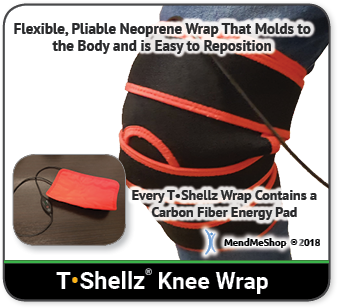 - Avoid Activities that Caused Your Knee Injury - While resting your injury it's also important to avoid all activities that may have caused your knee damage (especially any strenuous or repetitive movement). Continuing on with regular activities can increase the severity of your injury, turning a mild to moderate case of tissue damage into a downward spiral that can often severely impact your life. Also, trying to 'work around' your injury will eventually give rise to over-compensation injuries in other areas of your body.
- Use a Cold Compress or Ice Pack - Cold is very effective at reducing pain and inflammation - use at the onset of the injury and during flareups.
- Use a Knee TShellz Wrap® - Once swelling has been reduced, you can use your own blood flow to maximize your rehabilitation. Improved blood flow to your knee in most cases will help improve recovery time while improving overall health of soft tissue in the area. Knowing the body uses blood flow to heal soft tissue, this wrap is intended to maximize your rehabilitation by maintaining a healthy blood flow to soft tissue. Increased blood flow to damaged soft tissue should augment the bodys' own repair process, helping decrease recovery time while reducing re-injury risk. Promoting blood flow and heat to the treatment area will help to minimize the growth of scar tissue, increase tissue flexibility and help reduce onset of atrophy. This is why we recommend a TShellz Wrap treatment before undergoing activity - an increase in flexibility should help reduce risk of further injury while also assisting in the battle against atrophy. Heat via the TShellz Wrap® is especially helpful in dealing with chronic tendon & muscle injuries or on-going pain and stiffness from a strained knee.
- Use a Knee Support & Compression Sleeve - If you are experiencing discomfort or a feeling of knee instability, the MendMeShop Knee Sleeve is designed to help. The compression sleeve will move easily with your body with no stiffness in the sleeve itself despite being compression apparel. The sleeve is designed not to chafe the skin and reduce stiffness, swelling, and inflammation in the joint.
- For reducing discomfort while resting, (or to get some sleep) consider a High Quality Back Pillow and/or Knee Pillow for comfort while sleeping or sitting
- Try to Avoid Over Compensating for your Injury on your "'Healthy' (Non-Injured) Side - Many people will start limping or carrying objects with their opposite arm to compensate for their leg injury. Our bodies can adapt easily to any changes, including a hamstring injury. This quick adaptation could mean that you are already compensating for your injury without even knowing it!
When you compensate for your injury by using your opposite ('healthy') arm, leg, shoulder, knee, foot, etc. - then you are putting more weight and pressure on that side of your body. In many cases, your dominant side was injured (if you're right-handed this would be your right side) so your weaker side is trying to pick up the slack! The pain, stiffness, swelling and inflammation you then get on your 'healthy' side is something referred to as 'over-compensation pain'. Over-compensating for your injury can lead to other injuries and as such, it is important to be aware of how you are compensating so you can be extra careful; if there is an overcompensation flareup, treat this with the same conservative treatment methods to keep in under control.
- Rehabilitative Stretching under supervision of a PT or doctor. The intent of this is to provide you with increased range of motion, pain relief and strengthening of the surrounding tissue of the joint. Doctors or surgeons typically won't perform a surgery until they feel that their patient has put effort into treating their injury with conservative treatment methods. This may include up to 4 to 6 months of visits to a PT clinic. If you haven't experienced any improvement in your condition during that time then surgery may be considered. Agressive PT approaches may focus on forced or manual manipulation of the leg/knee - this means your physical therapists will be trying to move your knee past the point of comfort as they strive to increase range of motion and prevent further atrophy. This can be painful and end up making your injury worse if not done correctly. (reference: 1)
- Stretching - Stretching your joint in PT and at home will help you to regain your range of motion much faster than not stretching at all. Stretching in many ways is key maintaining good Range of Motion (ROM) in your joint, and stretching can be made much easier with use of a TShellz Wrap® before to warm up soft tissue, and a Cold Compress or Ice Pack treatment after to prevent any return of swelling and inflammation.
TShellz® Circulatory Boost Wrap
Once inflammation and swelling has been alleviated, nourishing and strengthening the muscle tissue around the knee joint and in the upper leg is recommended to realign the patella or strenthen the tendons and muscles surrounding the patella. The use of the Knee TShellz Wrap® will increase blood flow in the treatment area while helping improve the flexibility of soft tissue.
When you stop moving your knee because it hurts the amount of blood that flows naturally to your knee joint is reduced, limiting your body's natural ability to heal itself. The Knee TShellz® Circulatory Boost Wrap compliments your body's natural healing process by promoting blood flow while you give your knee the rest it needs. Energy emitted from the Energy Pad stimulates blood flow to your knee, more than your body would ever be able to generate on it's own, giving your body the boost it needs to continue the reconditioning process. This enhanced blood flow helps speed tissue repair, whisk away toxins and dead tissue, and rejuvenates soft tissue for improved elasticity. Circulatory Boost enhances your body's own healing process by simply increasing the amount of blood that flows to your leg and knee to improve the health of your tissue by delivering an abundance of nutrients to the area.
In addition, improved blood flow helps reduce the risk of atrophy in your muscles. When you stop moving your leg and knee due to pain, your muscles and other tissue can become weaker and dead tissue and toxins in the area can cause further tissue deterioration - this can lead to atrophy (muscle weakness and/or deterioration) in your quadriceps, hamstrings and other leg muscles. The Knee TShellz Wrap® is an amazing tool that can be used to help combat this problem.
By clearing the area of toxins and increasing the amount of oxygen and nutrients to your IT band, leg muscles, and knee the risk of atrophy is greatly reduced. Keeping your knee and leg tissue as healthy as possible throughout the healing process will allow you to improve strength again once your pain has gone and your knee has healed.
Conservative Treatment Tools Our Clients Have Used to Help Limit Damage & Boost The Body's Soft Tissue Repair Process to the Knee at Home:
- A Cold Compress or Ice Pack to reduce inflammation wherever there is pain and/or swelling (as soon as possible).
- A Knee TShellz Wrap to increase blood-flow to the knee area (a Localized Enhanced Circulatory Response® Treatment).
- MendMeShop Arnica Pain Cream for temporary relief of pain due to sore muscles and joints.
- A High Quality Knee Pillow if you are experiencing discomfort when resting or trying to sleep (or you want .
- A Knee Compression Support Sleeve for light tendon/muscle support and risk reduction of further injury.
- An Exercise & Stretching Plan to prevent muscle atrophy and shortened tendons in the Knee joint. A proper plan will increase elasticity and strengthen the muscles and tendons in the hip, knee, and ankle.
Conservative treatment tools just like these have been used successfully by thousands of knee injury sufferers - just like you.
TShellz Wrap® = Enhanced Blood Flow in the Treatment Area
We believe the use of TShellz Wraps® for boosting blood flow to soft tissue in the area of application is one of the most under-utilized home treatment options available on the market today. We have client after client that have tried many options out there and have been amazed at how effective and fast the TShellz Wrap treatment helped relieve their pain while increasing blood flow in the knee.
With regular use of the Knee TShellz Wrap:
- Your pain will be reduced*.
- Due to increased blood flow, soft tissue in the treatment area on the knee will be expected to recover at an accelerated rate with reduced potential for re-injury*.
- Tissue in the treated area should experience a larger range of motion and increased extensibility of collagen tissue* due to the heat effect on soft tissue. This should translate into a reduced rate of re-injury occurrence as soft tissue is known to lengthen and become more flexible when exposed to warm temperature. (*Chapter 9 of "Therapeutic Heat and Cold", 4th edition.
(amazon.com link - Ed. Justus F. Lehmann, M.D., Williams, and Wilkin)
Who Should Use the Knee TShellz Wrap®
We recommend the use of a Knee TShellz Wrap®:
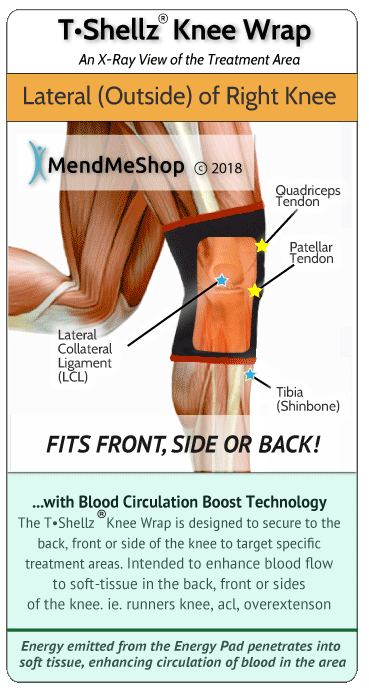
- If you have bursitis, tendinitis or other soft tissue damage in your knee, then the Knee TShellz Wrap® will provide the all-important function of boosting blood circulation where it is needed most.
- If you are dealing with soft tissue conditions affecting your range of motion.
- If you have a chronic soft tissue knee condition that has lasted for years- this device is intended to kick start the recovery process and help strengthen the surrounding and supporting tissues.
- If you are still working with a knee strain or mild tear, the TShellz Wrap® will help relax tissue in the knee prior to work and after a day at the job.
- If you are still trying to enjoy your favorite activities such as gardening, tennis, golf, etc - use the TShellz Wrap® prior to activity to help reduce risk of re-injuring or re-aggravating those targeted tissues.
- If you are suffering from bursitis and want to treat a major source of it (inflammation and damage to tissue surrounding the bursa sac). Through trauma, overuse or degenerative changes, muscle and tendons surrounding the bursa sacs will tighten and constrict. When they do, they place pressure on the bursa, causing it to become irritated. Applying a TShellz Wrap® to the area will help relax tissue in the treatment area, taking pressure off the bursa.
- If you are experiencing atrophy in the knee and want to reduce the chance of re-injury while stretching - this is a perfect treatment to use before activity, by enhancing blood flow and elongating soft tissue.
- If you have been to a clinic for some form of massage or stretching and your PT or physician has recommended conservative treatments for home.
- If you are experiencing tightness in your muscle(s) and want to reduce the chance of re-injury while stretching - we recommend the use of a TShellz Wrap® before you stretch.
We believe the use of TShellz Wraps® for boosting blood flow in the area of application is one of the most under-utilized home treatment options available on the market today. We have client after client that have tried many options out there and have been amazed at how effective and fast the TShellz Wrap treatment can relieve pain and increase localized blood flow in the treatment area.
The TShellz Wraps significantly increase bloodflow to tissue in the treatment area - period. With regular use of the
Knee TShellz Wrap:
- Your pain will be reduced*.
- With increased blood flow, tissue in the area will recover at an accelerated rate*.
- Due to increased warmth in soft tissue, the corresponding joint will have a larger range of motion and increased extensibility of collagen tissue*. This should translate into a reduced rate of injury occurrance as soft tissue becomes more flexible.
(*Chapter 9 of "Therapeutic Heat and Cold", 4th edition.
(amazon.com link - Ed. Justus F. Lehmann, M.D., Williams, and Wilkin)
Attach the TShellz Wrap® around your leg, plug it in and let the Energy Pad do the work!
*Know that every personal soft tissue injury is unique and the TShellz Wrap may not work for everyone. This is why we offer a 60-day full money back return on all our TShellz Wrap devices. During your recovery, you will probably have to modify and/or eliminate any activities that cause pain or discomfort in your knee area until your pain and inflammation settle. With these easy to use home therapies - the TShellz Wrap® and a Cold Compress or Ice Pack, you will notice an incredible improvement in a reduction of pain and an increased range of motion. The more diligent you are with your treatment and rehabilitation, the faster you will see successful results and the sooner you can return to the activities you enjoy - without pain!
Product Advisors are available 9:00 am to 5:00 pm Eastern Standard Time Monday to Friday.
Learn More About Knee Injuries & TreatmentsI want to learn more about post-surgery recovery. I want to learn all about common causes of knee pain. I want to learn more about TShellz Wrap® Circulatory Boost I want to learn more about Ice & Heat: Which Is Better For Treatment? I want to learn more about Knee Treatments. I want to learn more about Runners Knee. I want to learn more about Hoffas Syndrome. I want to learn more about Knee Arthritis. I want to learn more about Knee Trigger Points.
FREE SHIPPING ON ALL PRODUCTS CURRENTLY ENABLED
60 DAY TRIAL PERIOD
During your recovery, you will probably have to modify and/or eliminate any activities that cause pain or discomfort at the location of your soft tissue injury until the pain and inflammation settle. The more diligent you are with your treatment and rehabilitation, the faster you will see successful results!
|
Some Facts About Knees:
Approximately 19.4 million visits to physicians' offices in the US per year are due to knee problems.
The knee is a complex joint with many components, making it vulnerable to a variety of injuries.
Oral medications can mask the pain but do not aid in the healing of knee injuries.
Most knee injuries can be successfully treated without surgery.
Sadly, regardless of treatment, ACL injuries in high-school youths are associated with a 10-fold increased risk for degenerative knee arthritis later in life.
MendmyKnee (a division of MendMeShop) is an FDA registered company.
Every year, at least 1 in 3000 Americans between ages 14 and 55 tear an anterior cruciate ligament (ACL).
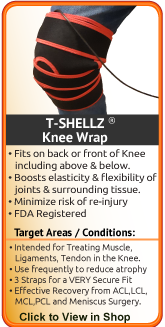



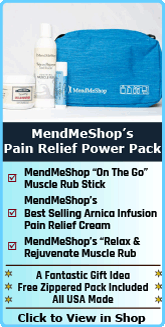
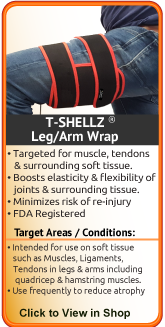
|








